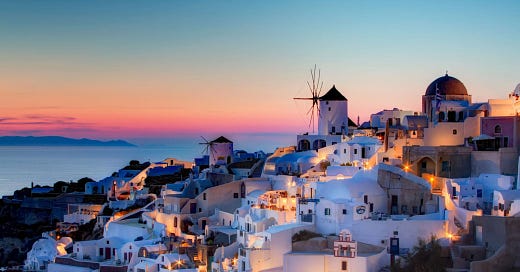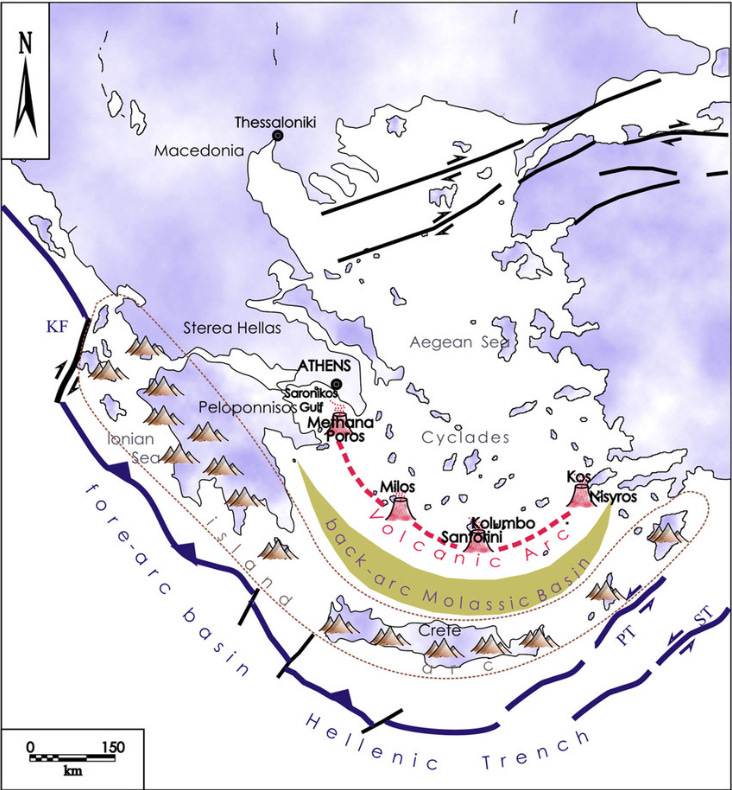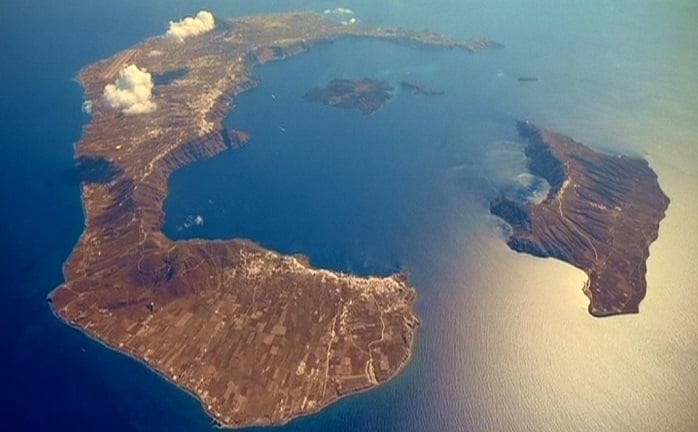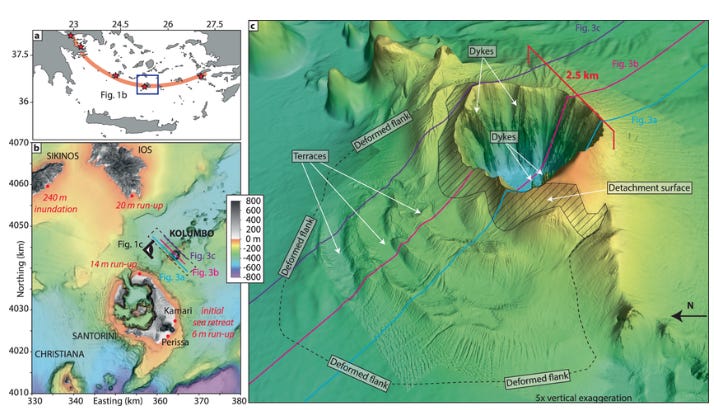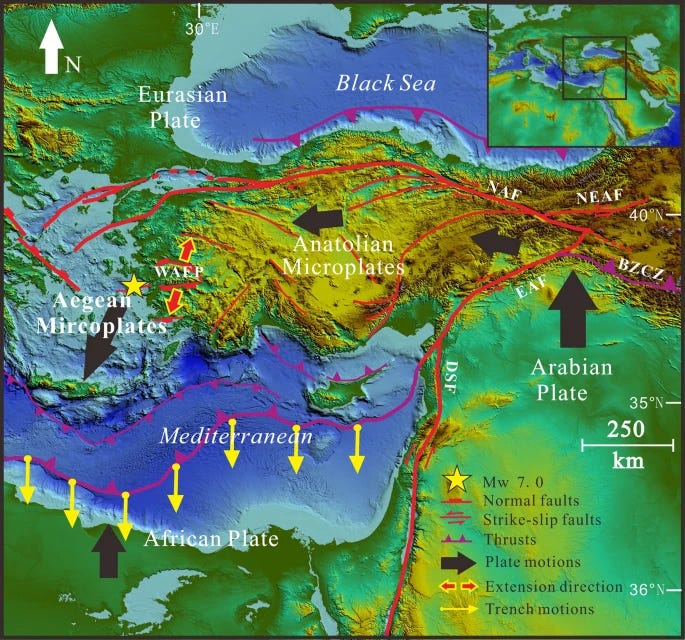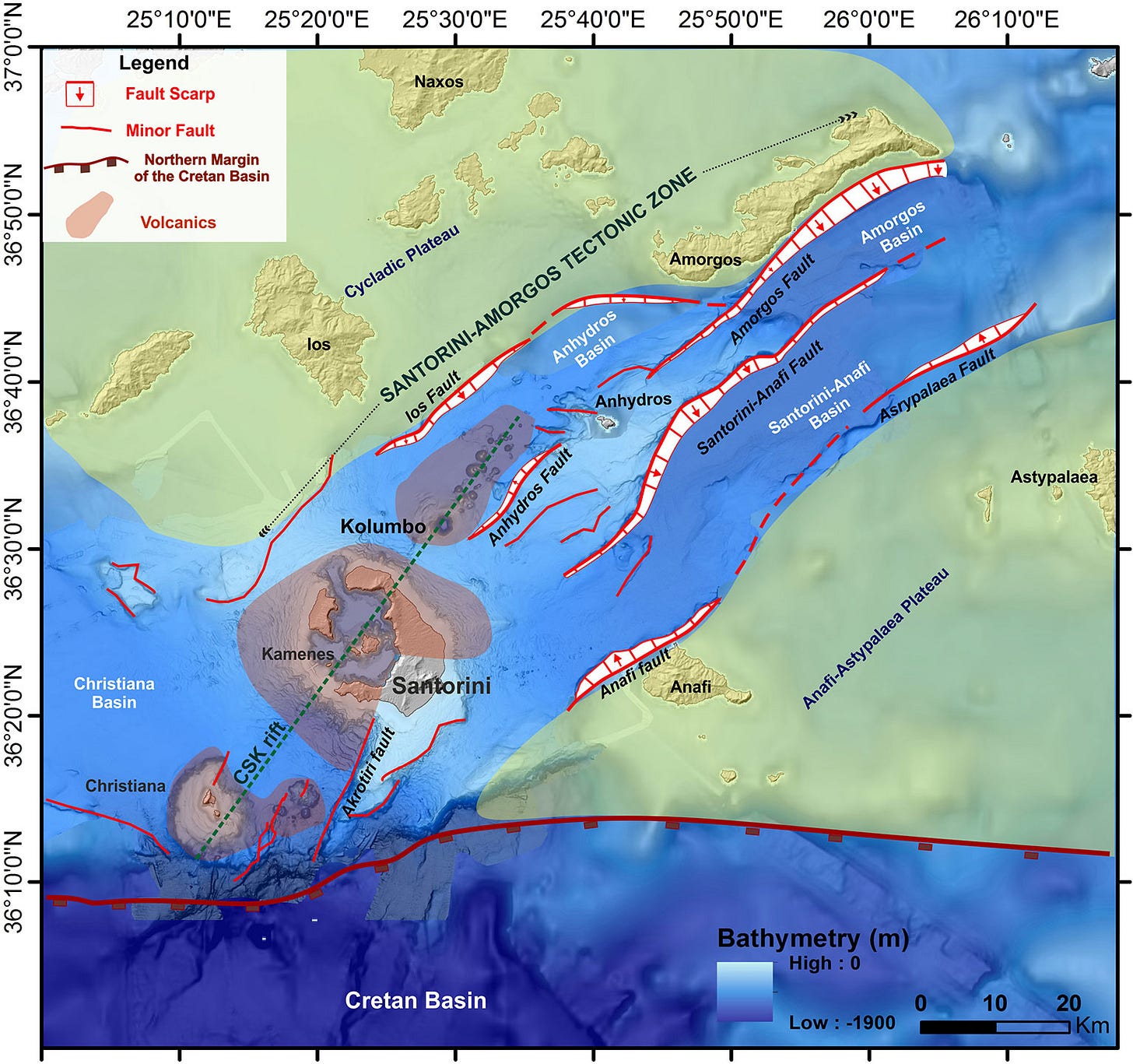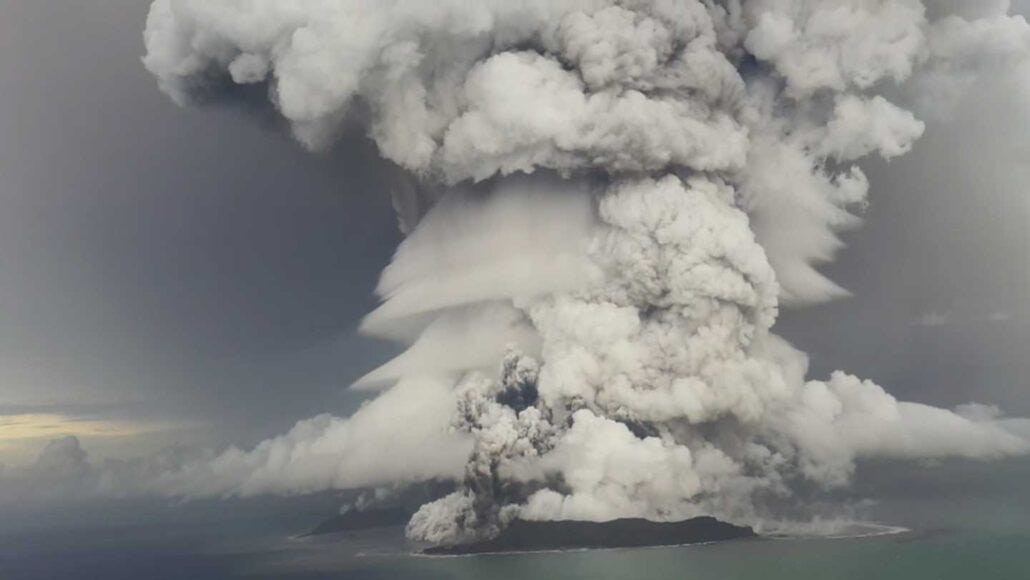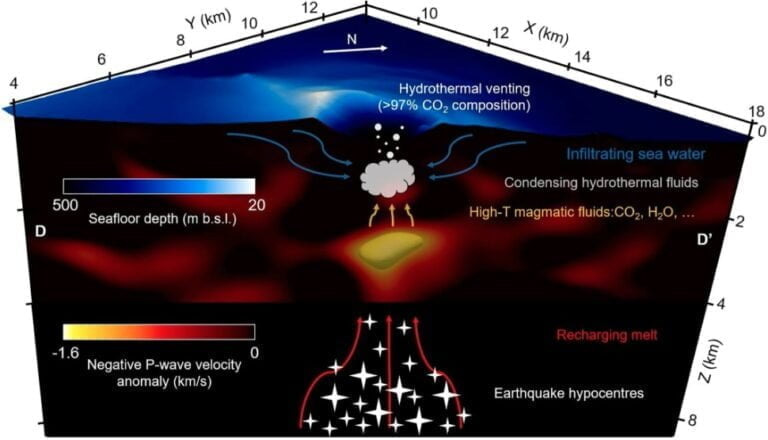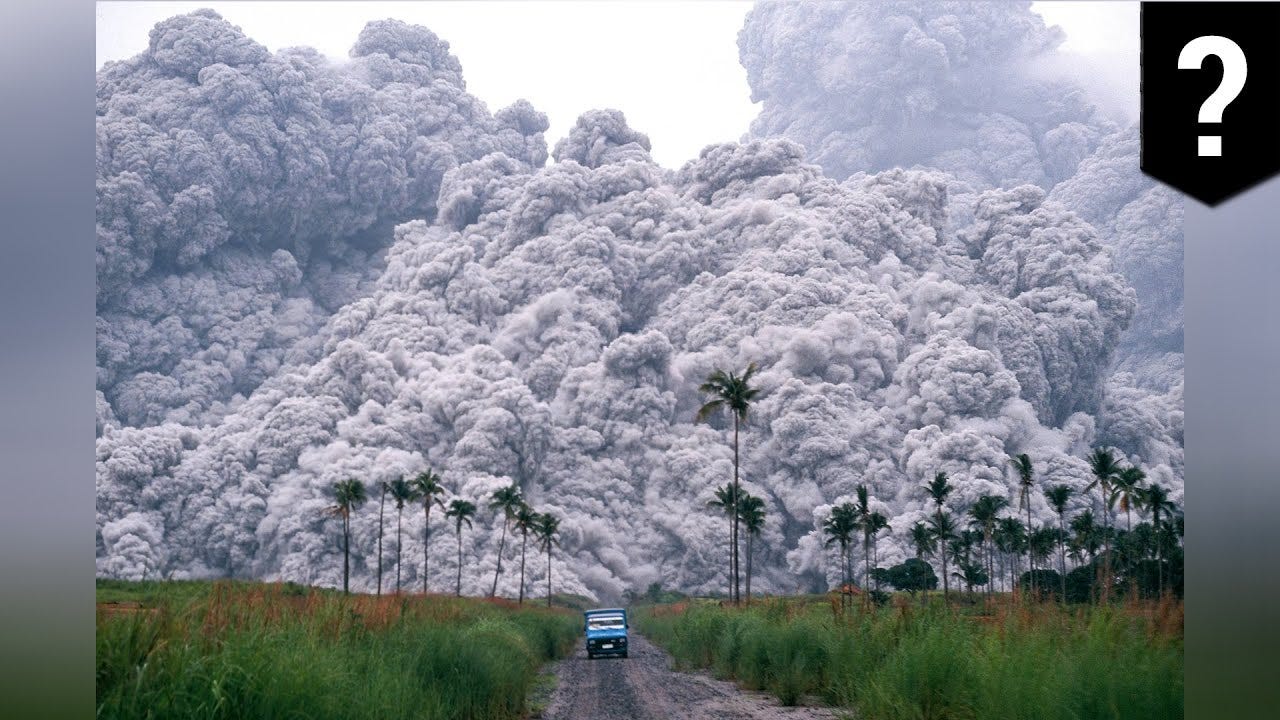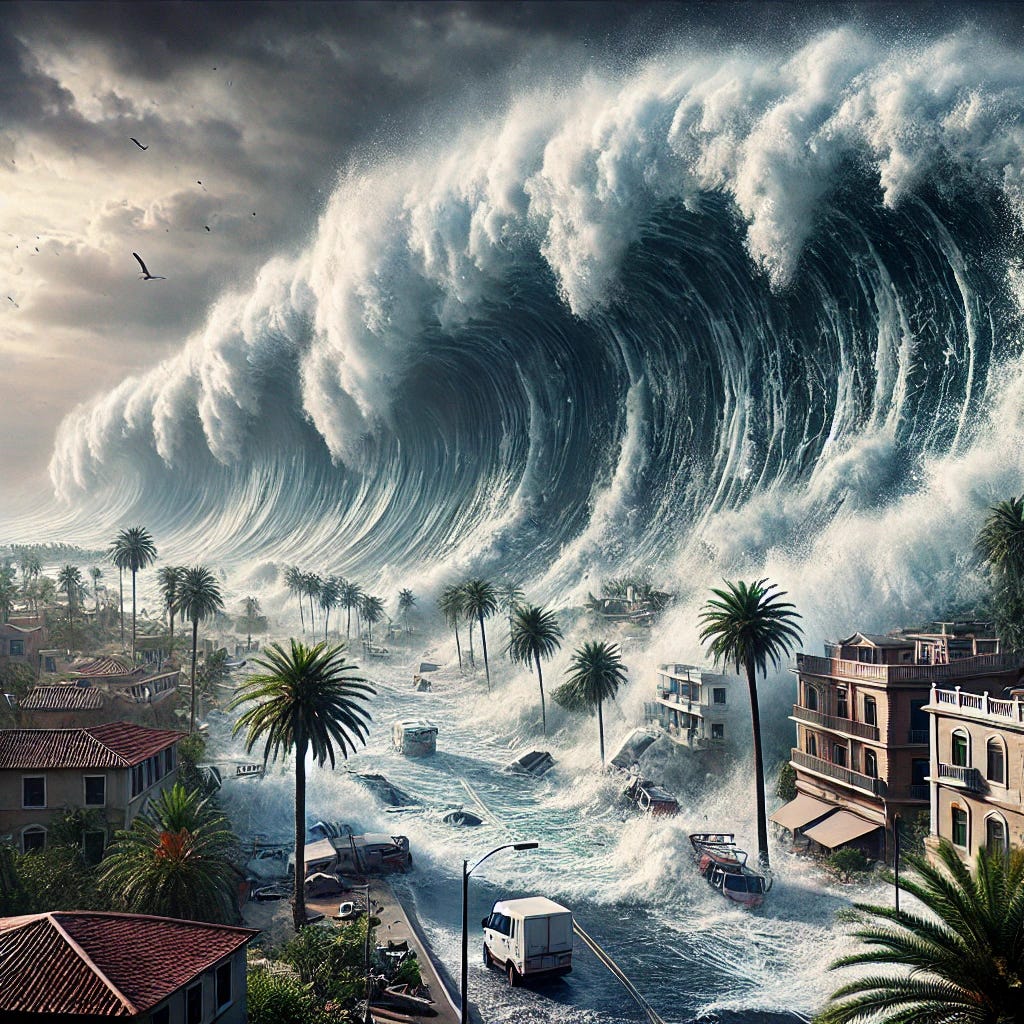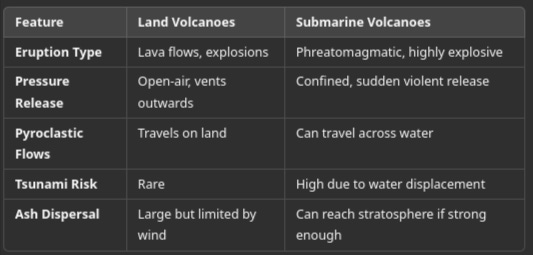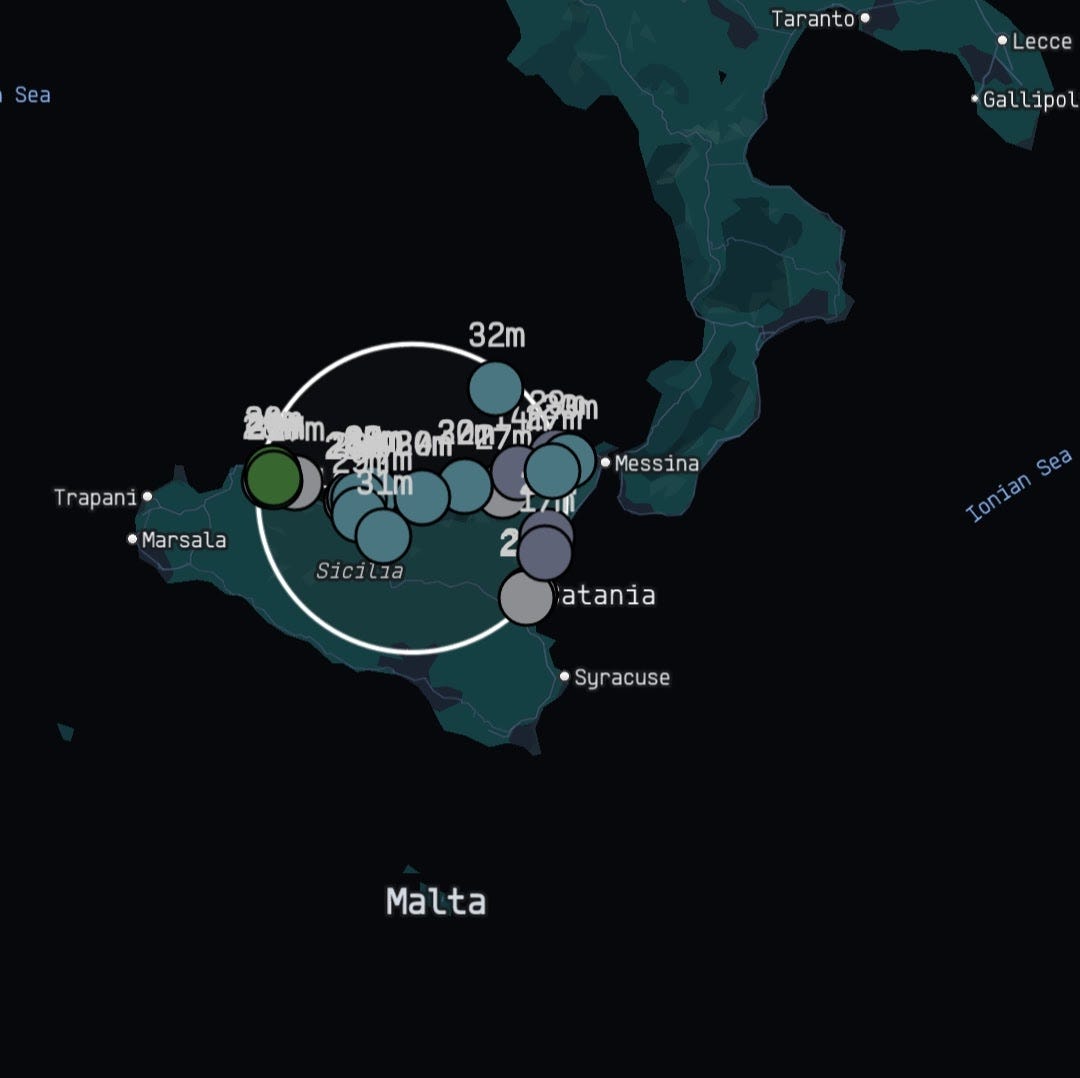Out of pure self-interest, I have gathered factual information from various sources because I can't stand amateurs inviting me to subscribe to their channel while talking to people as if they were idiots. In cooperation with and fact-checking from ChatGPT, here is an overview of what is REALLY happening, followed by my conclusion on what I THINK will happen.
Links to sources under the images.
The islands of Santorini and the submarine volcano Kolumbo sit within one of the most seismically and volcanically active regions in the world: the Hellenic Volcanic Arc.
This arc, stretching from the Methana Peninsula in the north to Nisyros in the south, is the direct result of the collision and subduction of the African Plate beneath the Eurasian Plate.
The forces at work in this region have created deep ocean trenches, earthquakes, and explosive eruptions, shaping both the land and human history. To understand why Santorini and Kolumbo exist today, we must first explore their geological history.
The Formation of Santorini: An Explosive Past
Santorini, or Thera, is not a single island but a volcanic caldera, formed by a series of catastrophic eruptions over hundreds of thousands of years.
The most famous eruption, the Minoan Eruption (~1600 BCE), was one of the most powerful volcanic events in recorded history, with an estimated Volcanic Explosivity Index (VEI) of 6-7.
However, it did not cause the immediate destruction of the Minoan civilization—though it likely played a role in its eventual decline due to climate disruptions, tsunamis, and economic effects.
Major Eruptions of Santorini
161,000 BCE (VEI 6) – One of the earliest massive eruptions, producing extensive pyroclastic flows and shaping the early island.
46,000 BCE (VEI 6) – Another major caldera-forming event, blanketing the region in ash.
Minoan Eruption (~1600 BCE, VEI 6-7) – The most famous eruption, which:
Created a massive tsunami (estimated 10-35 meters high) that struck Crete.
Spread volcanic ash across Anatolia, Egypt, and the Black Sea.
Left behind the Santorini Caldera, which still defines the island today.
197 BCE (VEI 3-4) – Formed the Palea Kameni island within the caldera.
1570-1950 AD (VEI 2-3) – Multiple smaller eruptions built the Nea Kameni islands.
Kolumbo: The Hidden Giant Beneath the Waves
The facts: Geological Structure of Kolumbo
Caldera and Crater
Summit Depth: The highest point of Kolumbo is about 18 meters below sea level.
Crater Size: The main crater is 3 km in diameter and over 500 meters deep.
Caldera Formation: The central part of the volcano collapsed after the 1650 AD eruption, forming a caldera similar to Santorini’s.
Magma Chamber and Hydrothermal Activity
Magma Chamber: Recent studies using seismic imaging have detected a large magma reservoir under Kolumbo, located between 2 and 4 km beneath the seafloor.
Hydrothermal Vents: The caldera floor contains active hydrothermal vents, which release hot, mineral-rich fluids into the seawater.
Gas Emissions: Significant sulfur and CO₂ emissions have been observed, indicating ongoing magmatic activity.
Hot Fluid Temperatures: Some hydrothermal vents emit fluids at temperatures over 220°C (428°F), creating unique deep-sea ecosystems.
The 1650 Eruption
Kolumbo is a submarine volcano located about 8 km northeast of Santorini. Although it remains hidden beneath the waves, it has a violent history. In 1650 AD, Kolumbo erupted with a VEI of 4-5, causing massive destruction:
A series of earthquakes (Magnitude 6-7) preceded the eruption.
The eruption was phreatomagmatic—magma came into contact with seawater, triggering violent steam explosions.
A 15-30 meter (50-100 ft) tsunami struck Santorini and nearby islands.
Large amounts of sulfur dioxide and toxic gases were released, suffocating people and animals on Santorini.
The eruption led to the collapse of the volcanic structure, forming a 3 km wide underwater caldera.
link
Now I would like to continue with a couple of words about the dynamics in the Hellenic Volcanic Arc:
The African Plate’s Slow Descent
At a rate of approximately 3-5 cm per year, the African Plate is being forced beneath the Eurasian Plate along the Hellenic Subduction Zone, located just south of Crete. This process, called subduction, is responsible for many of the geological phenomena in the region. The African Plate does not simply slide under the Eurasian Plate—it is sinking deeper into the mantle, pulled down by gravity, and creating immense pressure beneath the Earth's crust.
Crete: The Edge of a Continental Plate
Crete, the largest island in Greece, marks the northern edge of the subduction zone. The trench south of Crete, known as the Hellenic Trench, reaches depths of over 5,200 meters (17,000 feet), making it one of the deepest parts of the Mediterranean Sea. As the African Plate moves downward, it also pulls on the overlying Aegean Plate, stretching it and making it thinner. This thinning of the crust allows for magma to rise and feed the volcanic arc.
The Role of Magma Accumulation
As the African Plate sinks into the mantle, it melts due to intense pressure and heat. The water-rich minerals in the plate lower the melting point of the surrounding rock, generating vast magma chambers beneath the Aegean region. This molten rock slowly accumulates, rising toward the surface where it eventually fuels the eruptions of the Hellenic Volcanic Arc. Over time, these eruptions have given birth to volcanic islands, including Santorini.
This leads us to the fact, that during the last days, some alarming signals have been registered in the vicinity, like
The Rising Seafloor
Recent studies have shown that the seafloor around Santorini and its surrounding islands is rising. This phenomenon is most likely caused by:
Magma Accumulation Beneath the Crust
As magma collects in chambers under Santorini and Kolumbo, it pushes the seafloor upward.
The pressure from molten rock inflates the crust, similar to how a balloon swells before it bursts.
This uplift is often a precursor to volcanic activity.
Tectonic Stress from the African Plate's Subduction
As the African Plate subducts, it causes crustal deformation in the overriding Eurasian Plate.
In some areas, this leads to compression and uplift rather than just thinning.
Hydrothermal Activity and Gas Release
The venting of volcanic gases and fluids under the seafloor can cause parts of the seabed to rise over time.
This is seen around Santorini’s Palea Kameni and Nea Kameni islands, which continue to grow due to eruptions and hydrothermal activity.
Why Submarine Volcanoes Are Extra Explosive
Submarine volcanoes like Kolumbo and Hunga Tonga-Hunga Ha'apai tend to be far more explosive than land-based eruptions due to phreatomagmatic interactions—the violent contact between magma and seawater. When magma rapidly vaporizes seawater, it generates high-pressure explosions, releasing vast amounts of energy in seconds.
Kolumbo:
Key Factors Making Underwater Volcanoes More Explosive:
Superheated Water Turns to Steam: The instant contact of magma with seawater causes rapid vaporization, increasing explosive intensity.
Confined Pressure from Water: Unlike land eruptions, the overlying ocean creates additional pressure, making magma buildup more unstable and potentially leading to massive eruptions when pressure is released.
Pyroclastic Surges and Base Surges: These high-energy clouds of superheated ash, gas, and volcanic debris can travel up to 100 km across water (depending on the VEI), devastating coastal areas.
Tsunami Generation: The sudden collapse of underwater volcanic structures, along with explosive force, can displace massive amounts of water, leading to tsunamis exceeding 30 meters in height.
ChatGPT says this would be a 30m tsunami… for presentation purposes only.
Comparison: Land vs. Submarine Volcanoes
Recent seismic activity over Sicily and the central Mediterranean suggests that the African Plate may be experiencing a shift, either accelerating its descent or adjusting its orientation slightly southward. This shift could be responsible for:
Increased seismicity in Sicily and the surrounding regions, as stress accumulates along faults due to plate movement.
More frequent and intense earthquakes in the Hellenic Arc, with the potential to destabilize the crust and trigger volcanic activity.
A direct link between the movement of the African Plate and ongoing geological changes in the Aegean, including the uplift of the Santorini seafloor and increased magma accumulation beneath Kolumbo.
The earthquakes observed today in Sicily, some exceeding Magnitude 4.8, could be part of a larger-scale geodynamic adjustment. If the African Plate is indeed shifting downward more aggressively, it may act as a catalyst for Kolumbo’s next eruption.
With magma accumulation, rising seafloor, and increased seismic activity, it is (for me) highly probable that Kolumbo is preparing for an eruption sooner rather than later. Given the nature of submarine volcanic explosions, this could mean:
Pyroclastic flows could extend 30-70 km, impacting Santorini, Anafi, and potentially reaching Crete.
A tsunami up to 30 meters high could strike the Cyclades, coastal Greece, Turkey, Israel and possibly North Africa.
Toxic gas emissions could impact marine life and air quality across the Aegean.
Seafloor collapse could trigger further seismic instability, intensifying future earthquakes.
This activity may be linked to a shift in the African Plate, pulling downward or slightly southward, which could accelerate magma movement and crustal stress in the region.
The formation of a new volcanic island near Santorini.
A violent phreatomagmatic blast that could be heard across the Aegean.
At least for me, the signs are clear:
Kolumbo will erupt again. I don’t know if this week, next month or in 2 years, but from the logical standpoint the sooner the better, before even more magma manages to accumulate making the explosion stronger.
Let me know what you think!
